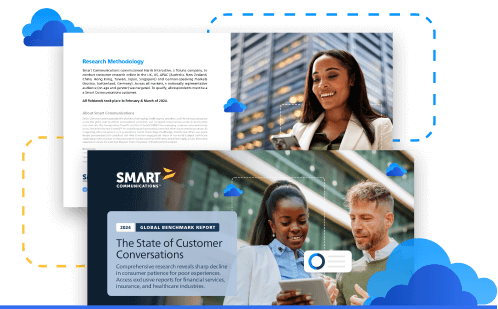What Is ESG and Why It May Be the Next Big Thing in Financial Client Reporting
By: Karen Oakland, VP Financial Services Marketing at Smart Communications
Historically, most investment strategies involve choosing assets and asset classes based on a finely tuned balance of expected net return and risk tolerance. And while that might still be true for many, a rapidly growing segment of investors are selecting investments with a different lens: Environmental, Social and Governance (ESG) factors.
How significant is this trend? According to Bloomberg, ESG assets “are on track to exceed $50 trillion by 2025, representing more than a third of the projected $140.5 trillion in total global assets under management.”
With such a massive amount of assets at stake, leading wealth management and private banking firms are racing to not only offer more ESG investment options but also to improve how ESG data is included in client reporting and other customer communications. In this post, we’ll explore what ESG is, why it’s growing in popularity and how to adapt reporting to give clients the ESG investment reporting information they crave.
What is ESG?
Environmental, Social and (Corporate) Governance (ESG) is the standard to which a corporation holds itself to sensitive topics, such as:
- Responding to climate change
- How the company (and its suppliers) treat employees
- The racial and gender diversity of a company’s leadership
- Data privacy and cybersecurity
And while that may sound subjective, ESG is all about data and measurement. Though not every area of ESG investment reporting is equally mature and data-driven, ESG is fundamentally about accountability and achieving concrete goals. This is now viewed by many in contrast with the traditional concept of Corporate Social Responsibility (CSR), which has been more focused on optics (what can a company do to appear like a good corporate citizen) versus what its actual impacts are, backed by quantifiable metrics.
ESG is not a new trend but has certainly risen in popularity in the past decade. In 2019, the Global Reporting Initiative (GRI) revealed that 93% of the world’s largest companies by revenue already report on their ESG performance.
Adeline Diab, the Head of ESG and Thematic Investing EMEA & APAC at Bloomberg Intelligence, summarizes why ESG is so important in today’s business environment: “The pandemic and the global race to net-zero carbon emissions have put ESG criteria into orbit – from niche to mainstream to mandatory. ESG is fundamentally reshaping the financial industry, becoming part of financial reporting. This is in part due to mounting scrutiny from regulators, markets being more sensitive to ESG-related news and asset owners appointing managers on the basis of ESG across asset classes.
“ESG is fundamentally reshaping the financial industry, becoming part of financial reporting.”
What is ESG Investing?
As we highlight in our recent ebook, “5 Trends Shaping the Next Generation of Client Reporting,” investors globally are increasingly likely to invest according to their values. This style of investing has been known as Socially Responsible Investing (SRI). Especially prevalent among younger generations who will become the beneficiaries of the $68 trillion global wealth transfer over the next 25 years, investors want to “put their money where their ‘heart’ is.”
Social issues such as climate change and racial justice are causing investors to think critically about the kind of companies they want to have in their portfolios. According to Accenture, “Generation Z and Millennial investors were more than twice as likely as Baby Boomers to have asked their advisor about ESG investments (80% and 63%, respectively, versus 27%).
And this trend isn’t just about rosy altruism. Increasingly, investors believe that companies who score highly in ESG criteria perform better in the market, especially over the long term. As investors weigh possible options for investing, they’re asking tough, ESG-related questions like:
- Enterprises have sensitive data stored around the world and with third parties. How well can they defend against cyber-attacks, and what might the financial fallout be if they aren’t well prepared?
- Many utilities and industrial companies need plentiful water at adequate temperatures to operate. How robust are their plans to confront possible water scarcity?
- Many consumer-facing organizations have suppliers in countries with weak labor laws. Can they prevent human rights violations and maintain a stable workforce that meets consumer demands?
- Most large enterprises serve diverse markets. Do senior leadership and the board of directors have the diverse backgrounds and skills to understand and meet the needs of their customers?
The Challenge: ESG Data Is in a State of Flux
So, if more people want to invest in firms with good ESG ratings, and more companies are sharing their ESG data, it should be easy for wealth managers to advise their clients on where they should invest, right? Wrong, for one big reason: as of today, there is no single, universally agreed-upon standard for ESG ratings. In fact, research from ERM Group suggests that there are “600+ ESG ratings and rankings existing globally as of 2018,” a number that has only increased since then.
While many of the largest global enterprises have chosen GRI (Global Reporting Initiative) as their reporting standards, there’s not 100% agreement, and until that time, it’s important to have flexibility in which data sources you pull from.
How to Incorporate ESG Data in Client Reporting
Despite the complexities around ESG ratings, with the right solution, it can be relatively simple to give clients the ESG insights they increasingly desire. And while this may seem to be a “nice to have” today, it soon will be table stakes for every investment performance report. Here’s what to look for in a client reporting solution that will meet your ESG reporting needs both now and in the future.
- Leverage open APIs to pull in the best ESG data sets as the category evolves. As mentioned previously, the ESG data landscape is rapidly evolving. That’s why it’s important to choose a client reporting solution that can pull in a variety of data sets via open APIs. This way, you can give clients whichever ESG data set is considered “best” or “optimal” at a given moment in time – and easily switch or offer multiple options. Leveraging API calls also ensures that the ESG data a client sees in their report is as up to date as possible, as it can be refreshed whenever the client logs in or reloads their reports. Save yourself massive headaches down the road by building in flexibility from the start. Your future self will thank you!
- Infinitely customizable ESG reporting based on client preferences. Even within ESG ratings themselves, there are so many ways to slice and dice the data depending on what the client cares about most. Are they interested in a company’s overall ESG impact? Or just their environmental score? Or diversity and inclusion? Wouldn’t it be great to be able to sort and filter ESG data in this way? Choose a client reporting solution that allows clients to build customizable reports that show the exact view of data they’re most interested in. Bonus points go to solutions that have unlimited dashboards, pre-built modules and the ability for advisors to build reports on behalf of their clients in minutes. Because every client will have different wants and needs, the ability to infinitely customize his or her overall report, including ESG elements, will go a long way toward improving client satisfaction and loyalty (and save advisors the pain of manually producing bespoke reports).
- Think holistically and view ESG reporting as part of a scalable communication platform. While it may be tempting to buy a one-off ESG ratings solution, it’s a good idea to take a step back and think strategically. As our work with all of the G15 has revealed to us, having a scalable customer conversations management platform in place first provides a sturdy foundation for client reporting solutions to build upon and integrate into your tech stack. This way, you can pull any ESG reporting elements you (or the client) have created and insert them into dynamic communication templates. For example, with very little effort on your part, you can send each customer a personalized ESG newsletter showing the same views they created in their custom reporting.
Want to learn more about how next-generation financial reporting solutions can transform your business? First, check out our digital-first solution for Client Reporting, which enables wealth management and private banking firms to eliminate time-consuming processes around creating bespoke reports. Or, contact us if you’d like to see how Smart Communications can support your ESG reporting strategy.



